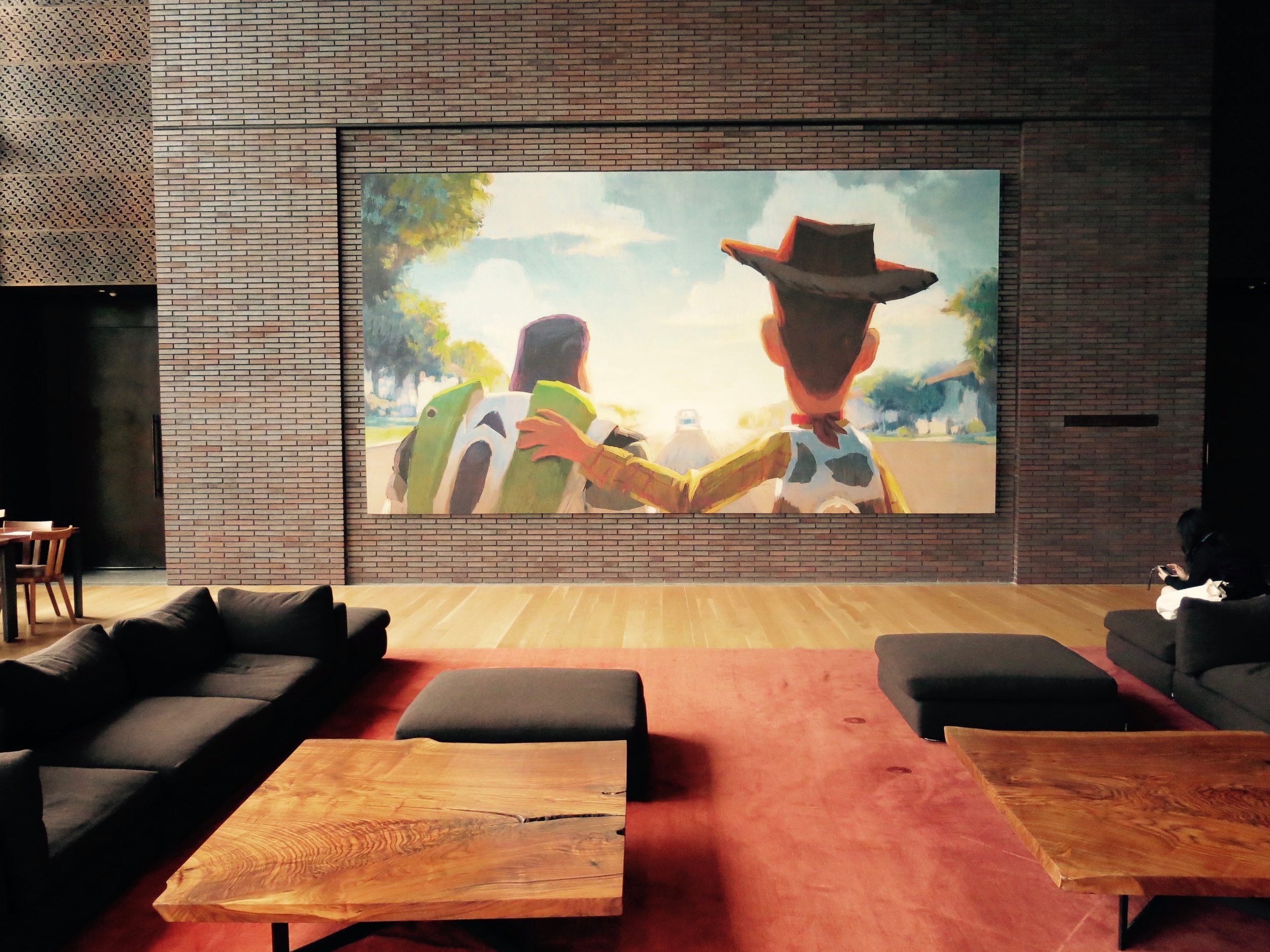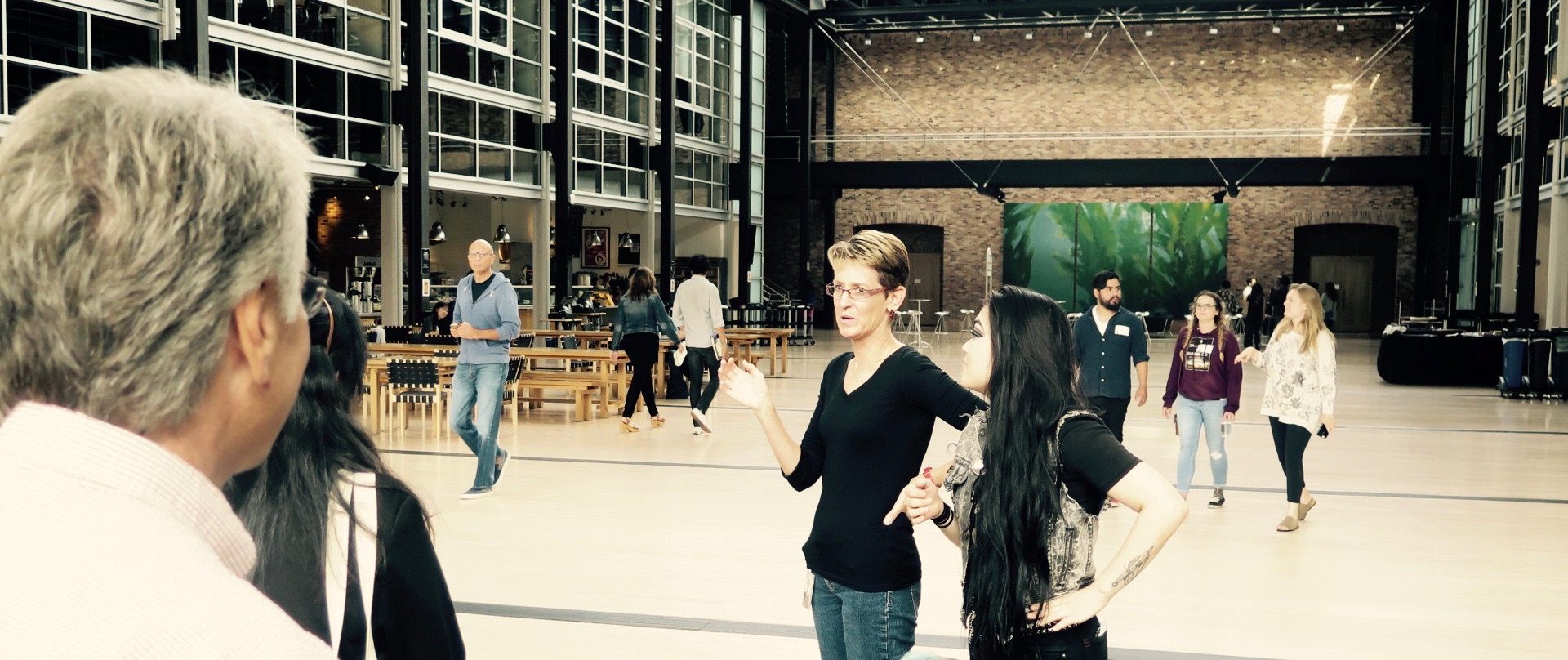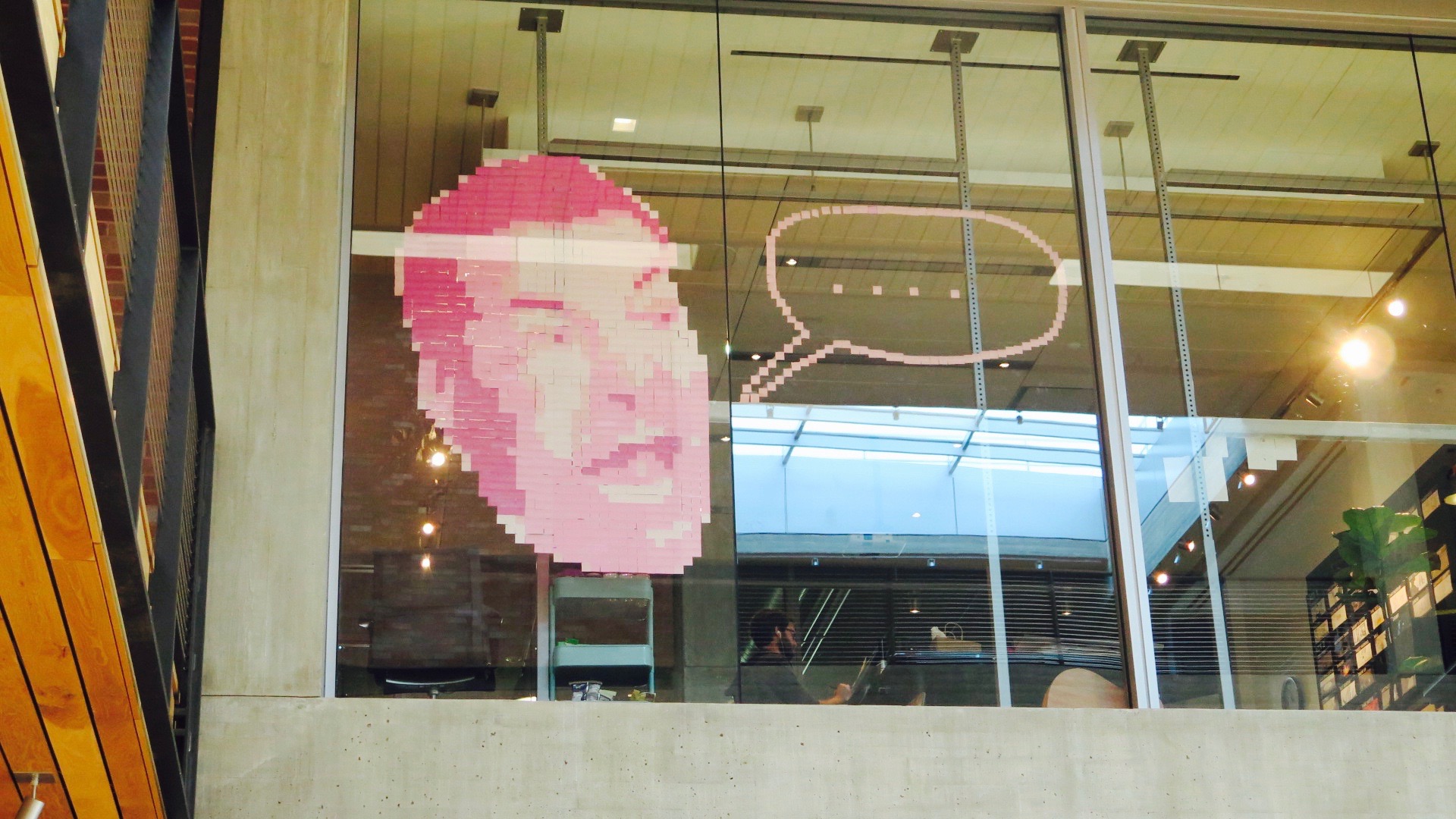
This past Friday I spent the morning over at Pixar's campus, taking part in an end of program information tour and luncheon. I was so stoked to visit "Brooklyn ", which is considered the development building for new films. What I remembered most from my last visit that added to this visit was, one gets the sense that ideas are afoot everywhere. One stand out moment of the tour was my encounter with story legend Mark Andrews. Let me set the stage:
We had just entered into Brooklyn and the first thing I noticed was Dice Tsutsumi's large color script panel of the final shot in Toy Story 3, where Woody and Buzz are watching Andy drive off towards college, had been replaced with a concept drawing of Merida by Steve Pilcher.


As as we are walking with Tia Kratter I lookup and what do I see a huge posted note head of Mark Andrews.
I laughed and turned to Tia asking "is that Mark?" She responded "yes, that's his story room." As I brought my glance back down and to my left, I saw a figure approaching and everything went into slow motion. The figure that was approach was indeed Mark, looking as if he had heard me asking about him on cue. I gestured the universal motion of acknowledgment towards him, the "man nod" and he reciprocated; before exiting stage left before the group I was with noticed him. I slowly walked towards the hall he had turned down, in order to ask him a question. At that moment as I peered down the hall the penny whistle and string melody from the ending of The Usual Suspects began to play in my mind, and just like that he was gone!
To me Mark is hands down the most inspiring story artist, living today. His methods of storyboarding and directing are unparalleled, compared to his contemporaries. I first discovered Mark while watching the behind the scenes feature's on the DVD version of The Incredibles.
Below are two interviews on Mark. The first is from Wired magazine conducted during the rollout of Brave. The second is a phone interview from ScreenwritingU. Also, here's a great interview with Mark Andrews and Ted Mathot from the Spline Cast Archives.Enjoy!
JIM MACQUARRIE 06.18.12 10:43 AM
MARK ANDREWS has worked in animation and live-action as a storyboard artist, story supervisor, writer, and even as a voice actor, including The Incredibles, John Carter, The Iron Giant, Spider-Man, Samurai Jack and Star Wars: Clone Wars. With Brave, he makes his debut as a feature film director.
Andrews didn’t set out to become an artist or animator. “I kind of fell into animation. I’ve been drawing all my life just because I like drawing,” he explained. In high school, he planned on enlisting in the Marine Corps, but his friends all told him he should do something with his drawing talent, even though he had never taken an art class. He enrolled in some drawing classes at the city college, where he found out about CalArts, the art school founded by Walt Disney. “I said, I can actually have a career where I’m just drawing all the time? Done. Check, and that’s about as far as my ambition went. Everything else, doors just opened for me and I just jumped through.”
One of the doors that he “just jumped through” was working with Brad Bird, the director of The Incredibles and Iron Giant, as well as Mission Impossible 4. Andrews has been labeled as “Brad Bird’s right hand,” and they have worked on many projects together. “When Pixar approached Brad Bird to come up here and make a film with Pixar, there were about 12 of us that he brought up from his Iron Giant days. He calls us his dirty dozen, because we make movies guerrilla style. We do whatever it takes to get it done and we’re down and dirty and, you know, coming in to this hallowed halls of Pixar, you know, we were like garbage.” But the attitudes soon changed, Andrews says. “So we kind of came in and kind of infected Pixar in a good way.”
Becoming a director was not something he ever planned for, and in fact, working for Pixar was something of a surprise; he claims that he was blacklisted at Disney after serving an internship at the studio.” I went to the Disney internship after Cal Arts, after four years of Cal Arts. I got my BFA. I was one of five who got the Disney internship. After that, three months of the internship they would never hire me again. Just being myself, being a rebel,” he says jokingly, concluding that “now I’ve shown them.” Andrews goes on to explain that he is not alone in this area; both John Lasseter and Brad Bird were also fired from Disney under similar circumstances. “Brad has a term for it. He says, ‘strong coffee;’ a lot of people don’t like strong coffee, but, sometimes strong coffee’s exactly what you need to wake up in the morning and get going.” According to Andrews, the problem is that the studio’s attitude is “We don’t want your ideas, we just want you to do it.”
There has been some controversy surrounding Brave, due to the fact that Brenda Chapman was replaced as director, despite writing the film and originating the concept. Andrews explained that this was part of the way Pixar does things; the story is the most important thing, and sometimes a new perspective is needed. There have been director changes on Pixar films in the past, most recently with Ratatouille. “Every project gets bogged down with story, every single one,” Andrews says, “Ratatouille also took forever and it got bogged down with storyboard and it just got stuck…this is just, you know, the thing that needed to happen to free it up, to break it.”
Pixar's relentless success at the box office with truly original tales has convinced screenwriters the world over that the animation studio holds the secret to amazing storytelling. In all honesty, hyperbole aside, Pixar does hold the secret to amazing storytelling, but they are more than willing to share it with the rest of us. Pixar's Brave writer/director Mark Andrews took a moment to describe the studio's story process in a phone interview podcast with ScreenwritingU's Jenna Milly.
What Andrews reveals during the interview about Pixar's story process may surprise you because it's not all that revolutionary:
I call the story process alchemy because we’re trying to turn lead into gold, and when we do, we don’t know exactly how we did it because it’s going to be different every time....
At the end of the day, it’s just trial and error. We go into it intellectually, but we come out of it using our guts, to feel that it’s right, to feel that we’re moved, to laugh and cry as if we were an audience. And that’s pretty much the trick, just a lot of trying it over and over and over again until it feels right.
I know what you're thinking: "Great. What am I supposed to do with that?" First, take a breath, and just calm down, and let's look at this rationally, like two adults.
Pixar's story process isn't the same each time they tackle a new project. As aspiring screenwriters, we may have tried several tools and techniques to help us craft our stories, and even found specific methods that work for us repeatedly, but every story is different, so the process naturally has to change to tell each unique story. Like Pixar, we may not even know exactly how we crafted our latest story, which is why we struggle every time we write a new story.
More importantly (to me at least, maybe not to you, I can't read your mind) is the second point: it's just trial and error to find a way to move an audience. That is such a simple phrase with two key concepts. As writers, we have to be willing to explore so many choices for our characters every step of the way to go beyond the obvious path, to stay ahead of the audience. At the same time, we have to move the audience emotionally as well as move them along with the story as it unravels.
Check out Jenna Milly's complete interview with Mark Andrews at ScreenwritingU. A quick note: the interview was conducted over the phone, so bear with the audio when it begins (pun intended). Your ear will adjust, and are you really going to complain when you get to listen to a Pixar storyteller?









